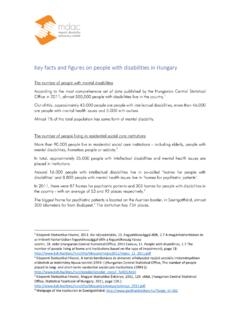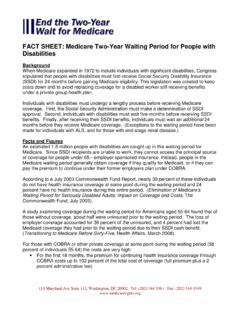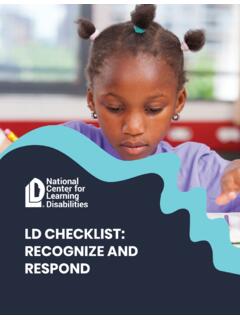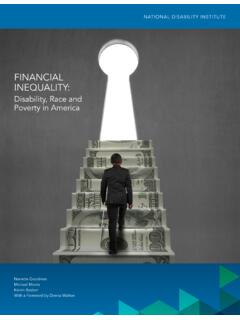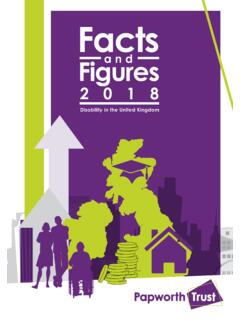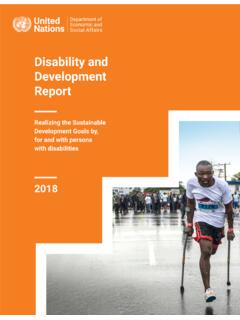Transcription of Disability in Canada: Facts and Figures
1 Page 1 of 3 (October 2019) Disability in Canada: Facts and Figures 15% of the world identifies as having a disabilityi According to the World Health Organization, 15% of the world s population (an estimated billion people ) identify as having some form of Disability . This represents the world s largest minority, and the only minority group that any of us can become a member of at any time. More than million Canadians live with some form of disabilityii More than million Canadians almost 22% of the population in this country aged 15 years and over are living with some form of Disability that affects their level of freedom, independence or quality of life.
2 This number does not include Figures for prevalence of disabilities among children and youth under 15 years old which means that the number of Canadians who are living with disabilities is even higher. More than 4 in 10 Canadians with disabilities have a severe or very severe Disability According to a 2017 Statistics Canada survey on Disability , 57% of Canadians with disabilities have a mild or moderate Disability and 43% have a more severe Disability (classified as having a severe or very severe Disability ). In all cases, the Disability was severe enough to limit them to some extent in their daily activities. Disability isn t always obvious The 10 Disability types identified by the in the Canadian Survey on Disability study are: seeing, hearing, mobility, flexibility, dexterity, pain-related, learning, developmental, mental-health related, and memoryiii.
3 Many disabilities are not visible. These so-called "hidden disabilities " still affect a large swath of Canadians. For example, the Learning Disability Association of Canada estimates that one in 10 Canadians has a learning disabilityiv. Disability is expensive A customized power wheelchair can cost more than $25,000. A porch lift can cost upwards of $5,000. A specially designed walker can cost up to $2,500. Modifications and renovations to make a home accessible can cost tens of thousands of dollars. Disability is expensive. For a family, it can cost more than $40,000 a year to care for a child with a severe Disability , yet some of these families have a total annual income of barely that much.
4 According to a 2017 New Data on Disability study, million Canadians with disabilities were unable to afford the aids, devices or prescription medication they require due to cost. Page 2 of 3 There s a real wage gapv Working aged adults without a Disability make a higher median after-tax personal income ($39,000) than those with milder disabilities ($34,300) and those with more severe disabilities ($19,200). More people with disabilities are underemployed According to a 2017 Statistics Canada report, approximately 59% of working-age adults with disabilities are employed compared with around 80% of those without disabilities .
5 As severity of Disability increases, the percentage of those employed falls from 76% among those with mild disabilities to 31% among those with very severe disabilities . More people with disabilities live in povertyvi According to a 2017 report, the highest rates of poverty (for those aged 15 to 64 years) were among those with more severe disabilities who were living alone or were lone parents. For those living alone, 6 in 10 were below the poverty line, as were 4 in 10 of lone parents. Regardless of Disability , 8 in 10 lone parents were women. Many companies aren't hiring people with disabilitiesvii Only four in 10 small business owners hired people with disabilities in 2013, matching levels from the previous year, according to a survey from BMO Financial Group.
6 Employers report being happy with hiring those with disabilitiesviii Despite the lack of opportunity for candidates with disabilities , more than three-quarters of the employers surveyed by BMO in 2013 said that after recruiting disabled workers, the hires either met their expectations (62%) or exceeded them (15%). Required workplace accommodations are not always metix The most commonly required type of workplace accommodations are flexible work arrangements (27%), workstation modifications (15%), and human or technical supports (6%). According to results from a Statistics Canada survey, the more workplace accommodations required from an employee, the less likely all their needs were met.
7 75% of employees with disabilities who required only one accommodation have their need met; however, this drops to 36% when they required three or more. Page 3 of 3 About one-third of youth with more severe disabilities are neither in school nor employed According to the Statistics Canada 2017 report, youth with disabilities are at a higher risk of not being in school or employed, and this increases with the severity of the Disability . About 15% of youth with milder disabilities are neither in school nor employed, compared with about 31% of youth with more severe disabilities . Among youth with disabilities who were neither in school nor employed, 87% had a mental health-related Disability , a learning Disability , or both.
8 Since those with mental health-related and/or learning disabilities accounted for 77% of youth with disabilities , this suggests they are disproportionately affected when it comes to being neither in school nor employed. Canadians identify large gaps between real-world accessibility and the idealx A 2015 survey revealed that the Canadian public sees vast room for improvement in their communities in terms of various barriers affecting the disabled, identifying large gaps between the real-world accessibility and the ideal. Students with disabilities are eligible for special loans The National Educational Association of Disabled Students has a website that lists information about awards and scholarships specifically for students with disabilities .
9 The site is designed to make it easier for disabled students to search for relevant bursaries. i World Health Organization, World Report on Disability , 2011. ii Statistics Canada, Canadian Survey on Disability 2017, 2017. iii iii Statistics Canada, New Data on Disability in Canada 2017, 2017. iv Learning disabilities Association of Canada, Learn more. v Statistics Canada, Canadian Survey on Disability 2017, 2017. vi Statistics Canada, Canadian Survey on Disability 2017, 2017. vii BMO, Four in 10 Small Business Owners Hiring people with disabilities , 2013. viii BMO, More than Half of Small Businesses Have Never Hired a Person with a Disability , 2013.
10 Ix Statistics Canada, Workplace accommodations for employees with disabilities in Canada, 2017, 2017. x Angus Reid Institute, Disability and Accessibility: Canadians see significant room for improvement in communities where they live, 2015

